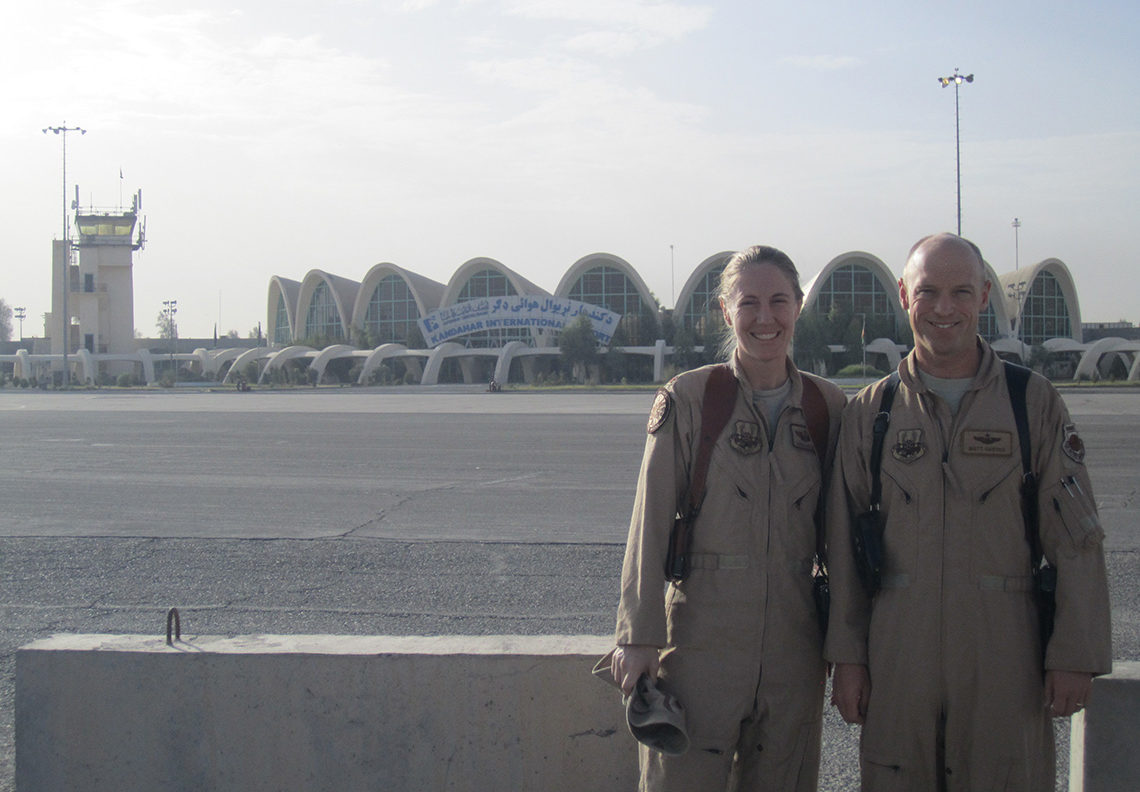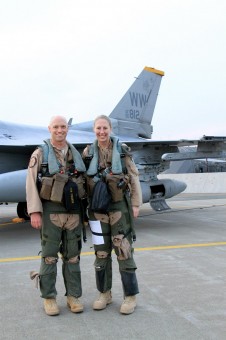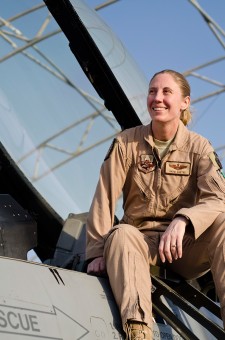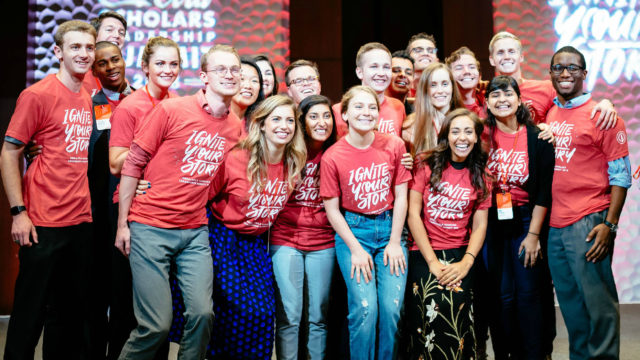
Celebrating our Veterans
By Katie Gaetke (1998) | Less than one percent of the U.S. population serves in the military. A 2011 Pew Research Center survey found that only one third of Americans age 18 to 29 have an immediate family member of any age who has served in the military. Yet the actions of this small portion of our population greatly affect the lives of every American.
I am proud to be among those who have served in the military. As we celebrate Veterans Day this month, I would like to share my experiences as a military officer and fighter pilot.
I graduated from MIT in 2002, where I participated in Air Force ROTC. In fact, it was ROTC (and the Coca-Cola Scholars Foundation) that allowed me to attend MIT, which was otherwise out of my financial reach.
 After basic pilot training in Oklahoma, I moved to Arizona for F-16 training. The F-16 is a single-seat, single-engine, multi-role fighter, designed for both air-to-air and air-to-ground combat. The broad range of missions makes flying challenging and interesting and is what I enjoy most about my job: there’s always something more to study, another skill to work on, or a new technique to learn.
After basic pilot training in Oklahoma, I moved to Arizona for F-16 training. The F-16 is a single-seat, single-engine, multi-role fighter, designed for both air-to-air and air-to-ground combat. The broad range of missions makes flying challenging and interesting and is what I enjoy most about my job: there’s always something more to study, another skill to work on, or a new technique to learn.
I’ve flown the F-16 during assignments to Cannon Air Force Base in New Mexico, Osan Air Base in South Korea, Luke Air Force Base in Arizona, and now Misawa Air Base in Japan. Over the last 10 years, I’ve participated in exercises from Alaska to the UAE, deployed to Iraq, flown air patrols over the U.S. on homeland defense missions, and become an instructor and evaluator pilot. But my just-completed deployment to Kandahar Air Base in Afghanistan this fall was one of the most rewarding (and at times frustrating) experiences yet.
In the months before a fighter squadron deploys to Afghanistan, its focus shifts from day-to-day training and upgrade missions to the specific Close Air Support (CAS) skills it needs downrange. During this “spin-up,” pilots focus on the types of bombs we’ll carry in Afghanistan, rehearse likely scenarios, review tactics, and study the rules of engagement. On one of our squadron’s first missions in Afghanistan, our youngest pilot flawlessly employed the most difficult weapon delivery we trained for, and he accomplished it single-ship. (We fly in pairs, called a “two-ship,” often teaming more experienced pilots with those who have less experience. In this case, his flight lead had to leave momentarily to air refuel.) This success, and many others that were less dramatic, validated our spin-up program, and justified the time and resources the squadron had spent preparing for the deployment.
The most rewarding missions were those where I could directly see the results of my actions. Often we were called to support a ground unit taking fire from insurgents. In one case when my two-ship arrived overhead, I could hear gunfire in the background as the voice on the radio asked us to fly low over the enemy position. Right away, the noise of the jets was enough to cause the firing to stop, and allow the friendly convoy to continue back to their base. It also demonstrated the heroism and restraint we ask of our ground forces, withholding fire to not put Afghan civilians at risk while under constant threat of improvised explosive devices and, in this case, under direct enemy fire.
Other times we were tasked to watch over a convoy of vehicles moving supplies to a forward operating base or coalition forces as they met with local village elders. We’d scout the route ahead and behind, using our infrared targeting pod camera to warn the ground forces of any suspicious activity. In the difficult, isolating terrain of Afghanistan, it brought them comfort and confidence to know we were above, ready to help them at a moment’s notice.
 There were certainly frustrating situations, too. There were times we arrived overhead only after the damage from an attack had been done and the enemy had melted back into the civilian population. On other missions, blowing dust kept us from being able to effectively see the ground, and sometimes even kept us on the ground away from the fight.
There were certainly frustrating situations, too. There were times we arrived overhead only after the damage from an attack had been done and the enemy had melted back into the civilian population. On other missions, blowing dust kept us from being able to effectively see the ground, and sometimes even kept us on the ground away from the fight.
Our squadron was only in Afghanistan for two months. Right as we were really hitting our stride, comfortable with the routine and familiar with the other units we worked with, it was time to make sure the next squadron was ready to take our place and begin the process of getting our people and jets home. That trip home came with mixed emotions: happiness to see family and friends, but awareness that many spend much longer away from home in much more challenging conditions than we experienced.
This Thanksgiving season, I’m thankful to be home again, but my thoughts are with the 68,000 U.S. troops in Afghanistan who are proudly serving our country. If you have a moment on November 11, email someone you know serving overseas, call up a veteran friend or family member, fly a flag, or find another way to thank someone who defended our freedom.
And if you have served yourself, from all of us … thank you.
Katie Gaetke is a 1998 Scholar and a Major in the U.S. Air Force. She lives in Japan with her husband, Matt, who also flies F-16s.




